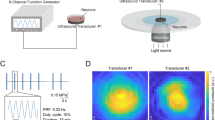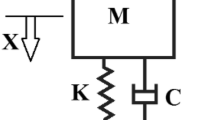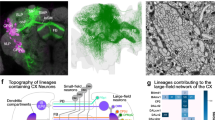Abstract
Vibration is an indispensable part of the tactile perception, which is encoded to oscillatory synaptic currents by receptors and transferred to neurons in the brain. The A2 and B1 neurons in the drosophila brain postsynaptic to the vibration receptors exhibit selective preferences for oscillatory synaptic currents with different frequencies, which is caused by the specific voltage-gated Na+ and K+ currents that both oppose the variations in membrane potential. To understand the peculiar role of the Na+ and K+ currents in shaping the filtering property of A2 and B1 neurons, we develop a linearized modeling framework that allows to systematically change the activation properties of these ionic channels. A data-driven conductance-based biophysical model is used to reproduce the frequency filtering of oscillatory synaptic inputs. Then, this data-driven model is linearized at the resting potential and its frequency response is calculated based on the transfer function, which is described by the magnitude–frequency curve. When we regulate the activation properties of the Na+ and K+ channels by changing the biophysical parameters, the dominant pole of the transfer function is found to be highly correlated with the fluctuation of the active current, which represents the strength of suppression of slow voltage variation. Meanwhile, the dominant pole also shapes the magnitude–frequency curve and further qualitatively determines the filtering property of the model. The transfer function provides a parsimonious description of how the biophysical parameters in Na+ and K+ channels change the inhibition of slow variations in membrane potential by Na+ and K+ currents, and further illustrates the relationship between the filtering properties and the activation properties of Na+ and K+ channels. This computational framework with the data-driven conductance-based biophysical model and its linearized model contributes to understanding the transmission and filtering of vibration stimulus in the tactile system.








Similar content being viewed by others
References
Arabzadeh E, Zorzin E, Diamond ME (2005) Neuronal encoding of texture in the whisker sensory pathway. PLoS Biol 3(1):e17
Azevedo AW, Wilson RI (2017) Active mechanisms of vibration encoding and frequency filtering in central mechanosensory neurons. Neuron 96(2):446–460
Baruah SMB, Gogoi P, Roy S (2019) From cable equation to active and passive nerve membrane model. In: International conference on advanced computational and communication paradigms (ICACCP), Gangtok
Beauchene C, Zurn C, Duan W, et al (2021) Towards robust control of PNS for chronic pain: modeling spinal cord wide-dynamic range neurons with structured uncertainty. In: Annual international conference of the IEEE engineering in medicine & biology society (EMBC), Mexico
Combe CL, Canavier CC, Gasparini S (2018) Intrinsic mechanisms of frequency selectivity in the proximal dendrites of CA1 pyramidal neurons. J Neurosci 38(38):8110–8127
David O, Friston KJ (2003) A neural mass model for MEG/EEG: coupling and neuronal dynamics. Neuroimage 20(3):1743–1755
David O, Cosmelli D, Friston KJ (2004) Evaluation of different measures of functional connectivity using a neural mass model. Neuroimage 21(2):659–673
Ding SY, Bhushan B (2016) Tactile perception of skin and skin cream by friction induced vibrations. J Colloid Interface Sci 481:131–143
Ermentrout B (1994) Reduction of conductance-based models with slow synapses to neural nets. Neural Comput 6(4):679–695
Felicetti L, Sutter C, Chatelet E et al (2023) Tactile discrimination of real and simulated isotropic textures by friction-induced vibrations. Tribol Int 184:108443
Fettiplace R, Hackney CM (2006) The sensory and motor roles of auditory hair cells. Nat Rev Neurosci 7:19–29
Fuchs PA, Evans MG (1990) Potassium currents in hair cells isolated from the cochlea of the chick. J Physiol 429:529–551
Gescheider A, Bolanowski SJ, Hardick KR (2009) The frequency selectivity of information-processing channels in the tactile sensory system. Somatosens Mot Res 18(3):191–201
Goodman MB, Art JJ (1996) Variations in the ensemble of potassium currents underlying resonance in turtle hair cells. J Physiol 497(2):395–412
Highstein SM, Rabbitt RD, Holstein GR et al (2005) Determinants of spatial and temporal coding by semicircular canal afferents. J Neurophysiol 93(1):2359–2370
Huang XL, Wang J, Yi GS (2023) Frequency-domain analysis of membrane polarization in two-compartment model neurons with weak alternating electric fields. Cogn Neurodyn
Hudspeth AJ, Lewis RS (1988) A model for electrical resonance and frequency tuning in saccular hair cells of the bull-frog. J Physiol 400(1):275–297
Kamiya H (2022) Modeling analysis of subthreshold voltage signaling along hippocampal mossy fiber axons. Front Cell Neurosci 16:966636
Moran RJ, Kiebel SJ, Stephan KE et al (2007) A neural mass model of spectral responses in electrophysiology. Neuroimage 37:706–720
Morris C, Lecar H (1981) Voltage oscillations in the barnacle giant muscle fiber. Biophys J 35(1):193–213
Prescott SA, Koninck YD, Sejnowski TJ (2008) Biophysical basis for three distinct dynamical mechanisms of action potential initiation. PLoS Comput Biol 4(10):1000198
Prsa M, Morandell K, Cuenu G et al (2019) Feature-selective encoding of substrate vibrations in the forelimb somatosensory cortex. Nature 567:384–388
Raheel A, Majid M, Alnowami M et al (2020) Physiological sensors based emotion recognition while experiencing tactile enhanced multimedia. Sensors 20(14):4037
Richardson MJE, Brunel N, Hakim V (2003) From subthreshold to firing-rate resonance. J Neurophysiol 89:2538–2554
Rinzel J, Ermentrout GB (1989) Analysis of neural excitability and oscillations. Methods in Neuronal Modeling, Cambridge
Roberts WM, Jacobs RA, Hudspeth AJ (1990) Colocalization of ion channels involved in frequency selectivity and synaptic transmission at presynaptic active zones of hair cells. J Neurosci 10(11):3664–3684
Rotstein HG (2013) Preferred frequency responses to oscillatory inputs in an electrochemical cell model: linear amplitude and phase resonance. Phys Rev E 88(6):062913
Rotstein HG (2015) Subthreshold amplitude and phase resonance in models of quadratic type: nonlinear effects generated by the interplay of resonant and amplifying currents. J Comput Neurosci 38:325–354
Rotstein HG, Nadim F (2014) Frequency preference in two-dimensional neural models: a linear analysis of the interaction between resonant and amplifying currents. J Comput Neurosci 37:9–28
Rotstein HG, Nadim F (2019) Frequency-dependent responses of neuronal models to oscillatory inputs in current versus voltage clamp. Biol Cybern 113:373–395
Rotstein HG (2014) Frequency preference response to oscillatory inputs in two-dimensional neural models: a geometric approach to subthreshold amplitude and phase resonance. J Math Neurosci 4(11)
Rudnicki M, Schoppe O, Isik M et al (2015) Modeling auditory coding: from sound to spikes. Cell Tissue Res 361:159–175
Sandykbayeva D, Kappassov Z, Orazbayev B et al (2022) Active tactile sensor for contact detection and force sensing via vibrations. Sensors 22(17):6456
Schreiber S, Erchova I, Heinemann U et al (2004) Subthreshold resonance explains the frequency-dependent integration of periodic as well as random stimuli in the entorhinal cortex. J Neurophysiol 92(1):408–415
Shao YT, Hayward V, Visell Y (2016) Spatial patterns of cutaneous vibration during whole-hand haptic interactions. Proc Natl Acad Sci 113(15):4188–4193
Sharp A, Houde MS, Houde MS et al (2019) Musicians show better auditory and tactile identification of emotions in music. Front Psychol 10:1976
Suver MP, Suver AMM, Sarkar S et al (2019) Encoding of wind direction by central neurons in drosophila. Neuron 102(4):828–842
Wilbers R, Metodieva VD, Duverdin S, et al (2022) Human voltage-gated Na and K channel properties underlie sustained fast AP signaling. bioRxiv
Witham CL, Baker SN (2012) Coding of digit displacement by cell spiking and network oscillations in the monkey sensorimotor cortex. J Neurophysiol 108(12):3342–3352
Acknowledgements
We are grateful to the anonymous reviewers for all of their valuable suggestions, which have substantially improved the quality and presentation of this paper.
Funding
This work was supported by the National Natural Science Foundation of China [Grant No. 62071324], and by the National Natural Science Foundation of China [Grant No. 62171311].
Author information
Authors and Affiliations
Corresponding author
Ethics declarations
Competing interests
The authors declare that they have no known competing financial interests or personal relationships that could have appeared to influence the work reported in this paper.
Additional information
Publisher's Note
Springer Nature remains neutral with regard to jurisdictional claims in published maps and institutional affiliations.
Rights and permissions
Springer Nature or its licensor (e.g. a society or other partner) holds exclusive rights to this article under a publishing agreement with the author(s) or other rightsholder(s); author self-archiving of the accepted manuscript version of this article is solely governed by the terms of such publishing agreement and applicable law.
About this article
Cite this article
Gao, T., Deng, B., Wang, J. et al. A linearized modeling framework for the frequency selectivity in neurons postsynaptic to vibration receptors. Cogn Neurodyn (2024). https://doi.org/10.1007/s11571-024-10070-8
Received:
Revised:
Accepted:
Published:
DOI: https://doi.org/10.1007/s11571-024-10070-8




